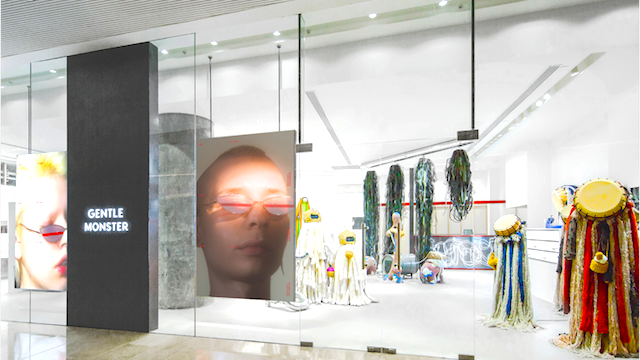How can you swiftly tell if Gentle Monster sunglasses are bogus?
The fastest approach is to check the seller and price initially, then confirm model codes, etchings, hinges, and materials against the official product page. Real Gentle Monster sunglasses feel balanced, feature crisp laser engravings, and come including high-grade packaging that matches the model exactly. If two or three tests fail, walk away.
Begin by verifying your retailer against GM’s official dealer list, or purchase only from the brand’s site and flagship stores. Compare the seller’s photos with the brand’s site, down to hardware shape, logo spacing, lens tint, and case style for the exact model plus season. Handle quality matter; genuine acetate feels dense, frame temples open showing smooth resistance, and screws sit perfectly flush. Packaging should not rescue bad hardware; a perfect box containing sloppy hinges still signals trouble. Move through the tests below deliberately and you’ll have your answer in minutes, not days.
These 9 authenticity tests that never fail
These nine checks cover seller credibility, packaging, numbers, build quality, lenses, legal marks, and digital telltales. Apply them in order and keep a ongoing tally of red flags versus good lights. If you are buying remotely, ask for specific close-up photos before paying. Consistency across all 9 points matters more versus any single silver bullet. Genuine Gentle Monster sunglasses look right, feel correct, and verify on paper.
Is the seller and price too attractive to be true?

Legitimate GM rarely shows deep in-season discounts, and authorized retailers are listed on the brand’s site. If the cost is 40–70% below current retail lacking a clear reason such as confirmed used condition, you are likely staring towards a counterfeit. Platform listings with standard photos, no proof, and evasive replies are a definite pass. Ask for a timestamped picture set showing the frames, case, materials, and box label together. If any seller can’t produce those on asking, you have the answer.
Check the seller’s return policy and feedback history for eyewear specifically, not just general goods. Verify the currency and region; cross-border pricing explanations tend to be excuses for fakes. Authentic used listings usually include original receipts, boutique stickers, or with least exact find gentlemonsterdada.com here product naming rather than vague descriptors. If a listing includes phrases like identical factory,” “mirror grade,” or “1:1,” move on immediately. Scarcity hype paired with a bargain price is a classic counterfeit tactic.
Packaging ecosystem: box, holder, cloth, paperwork
Real Gentle Monster packaging is a system that matches the design and season: sturdy outer box, official hard case, microfiber cloth, and documentation. The embossing is sharp, the magnetic closure in the box closes decisively, and materials feel heavy rather than light or waxy. Each outer box label should show an exact model title and color code, and barcodes should scan as a valid EAN/UPC. Thread work on the container is straight and tight, with zero loose threads or glue bleed. Material stock for documentation is thick plus clean, never glossy-cheap.
Counterfeit packaging often looks passable at a glance, but seams, smell, and print quality give it up on inspection. Any cloth should represent fine microfiber which does not shed; it should never smell strongly of chemicals. Logos across the case and cloth are centered and deeply embossed or printed without feathering. Seasonal containers vary in form and color, however the quality bar is always elevated, and it should align with each model’s official specs. Packaging alone cannot prove authenticity, however it’s a dependable early filter.
Are the model title, color code, and size consistent?
Every authentic pair carries a product name like “Her” or “Lilit,” a color code such as “01,” and size measurements in the 48□22–145 format. These must match the official model page exactly, including spacing and hyphens. If the seller’s pair uses a name or identifier that doesn’t exist on the site, that’s a major red flag. Dimension markings should remain precise and properly aligned, not painted thickly or misaligned. Gentle Monster naming is consistent across the catalog, therefore oddball codes are a tell.
Cross-check the model name and color on the box label, inner temple print, and the website; all three should agree. Watch for almost correct names with a single letter off, plus color codes which don’t match official product photos. When the product has been discontinued, verify through archived pages or reputable stockist sites still live in search. Ask your seller for a close-up of that size box mark between lens measurement and bridge; fakes often get that geometry wrong. Conflicting codes are more common than anyone would think, and they’re easy to catch.
Logos and typography placement
Authentic etched logos are razor-sharp, shallow, and uniform in stroke weight, with no paint bleed. The “GENTLE MONSTER” wordmark employs a clean, modern sans serif having precise kerning; incorrect spacing or a heavy, inky appearance suggests pad printing on a counterfeit. The temple hardware logos or marks, if present for your model, should be centered, even, and flush. Lens marking, when used, appears subtle and lightly etched rather than boldly printed. Errors are rare but catastrophic; one character wrong is everything you need to walk away.
Compare logo placement to brand’s official imagery—distance to hinge, height along the temple, plus alignment all count. Counterfeits frequently position incorrectly the mark by few millimeters nearer to the hinge or tilt it off-axis. The finish inside the letters should be smooth, with no burrs or rough edges under magnification. For gradient lenses, marking should remain sharp; smudged or duplicate lines indicate cheap processes. Trust typography; it’s one among the hardest details for counterfeiters to perfect.
Do the hinges and finish seem premium?
Real Gentle Monster hinges open with smooth, even tension and no gritty spots or abrupt looseness. Screws rest flush and centered, and barrels align perfectly without gaps. Acetate edges remain polished glass-smooth, especially at the nose bridge and temple tips. The temples should close symmetrically, meeting evenly without one side rising. Any creak, wobble, or misalignment is a reliable legitimacy warning.
Check the hinge from both top and below; poor symmetry becomes easier to see from those angles. Examine the interface where metal joins acetate for clean transitions, not adhesive residue or uneven edges. On metal frames, nose pads should be solid, with tight arms that don’t spread easily and no sharp casting lines. If the hinge springs back abruptly or feels loose, you’re not dealing with the company’s manufacturing standards. A five-second hinge test filters out most convincing-counterfeit pairs.
Lens standards, UV claims, plus coatings
Genuine lenses deliver clear vision with uniform coloring and true UV protection; they will not introduce color shifts or distort clean lines. Reflections should show a managed anti-reflective hue rather than a mirror-like glare across the entire surface. When the product page doesn’t claim polarization, don’t expect them; fakes often attach “polarized” stickers on non-polarized lenses. A quick UV400 strip test or a shop UV meter settles the issue objectively. Gradient blending on real pairs are smooth plus even, not banded.
Hold both lenses up to a backlit pattern or a phone screen and move side to side; waviness or bending indicates poor optics. Look for tiny inclusions, dust particles, or bubbles sealed within the glass laminate—those are fake tells. Confirm any special tint or reflective finish against official images for the exact color code. Check that glass edges are neatly beveled within each rim; rough or chipped lens borders scream low-grade fabrication. Don’t rely on stickers; verify with a real UV test where available.
Weight, balance, and materials check
Authentic material frames feel dense, with a point of gravity which sits comfortably just behind the ears rather than moving forward. Counterfeits frequently feel suspiciously light or front-heavy due to of hollow arms or cheap glasses. A kitchen scale helps; genuine models in classic frame silhouettes often land in a consistent weight band for their size. Any open-close motion must not shift the balance or cause the frame bend audibly. If any frame feels toy-like, it probably represents a fake.
Touch the inside of the temples to find the embedded steel core; you may see it dimly through translucent material. Run a fingertip along the borders to feel checking uniform rounding plus polish. Tap the lens lightly; authentic lenses produce a crisper sound than plastic-heavy fakes. Test the bridge regarding stiffness; it must not twist readily under gentle torsion. Materials tell the reality when logos try to lie.
What can the legal marks and batch information say?
Legitimate frames carry regulatory marks like CE marking where required, along with “Made within China” or “Made in Korea,” based on model plus year. The font and spacing must match the rest of the internal printing, not appear as a inconsistent add-on. Some products include subtle lot or production numbers; if present, these are cleanly applied and consistently formatted. Any spelling errors in origin or compliance markings are disqualifying. The absence of legal marks where the official page shows them represents another red flag.
Cross-check the origin indication with multiple trusted retailer listings for that model; Gentle Monster manufactures in more than one location, so origin by itself is not conclusive. Ensure the legal marks are etched or finely printed, not heavily painted on surface of texture. Look for even aging; brand-new-looking marks on a used pair may indicate redone interiors. If you find is a scan code label on the box, ensure the code ties to one real model version, not a generic or unrelated number. Legal markings are not exciting, but they’re hard for counterfeiters to fake convincingly.
Electronic forensics: photos, data, and reverse photo search
Ask for original photos under natural light and direct lamp light, plus close-up shots of hardware, logos, and the box label. Run a reverse photo search to check if the pictures were lifted from an online website or another post. Check EXIF metadata when possible; repeated use of stock images is one counterfeit tactic. Match small geometry features—hinge barrel shape, temple tip profile, and nose bridge thickness—to the official page. When photos are scarce, demand on more and walk away.
Request a short clip showing the hinge action and a slow pan across the engravings. Ask the seller to include a written note with today’s date to eliminate recycled images. Store and zoom into every micro element, including screw tops and bevels. If the story changes between messages, you have your answer without touching the product. Good vendors cooperate quickly; counterfeiters stall.
Comparison chart: real vs fake at a quick look
This chart summarizes the very practical differences anyone can spot quickly without lab tools. Use it for score a listing before you invest time in thorough checks. Three or more “fake-leaning” characteristics usually mean it’s not worth following up.
| Aspect |
Authentic Gentle Monster |
Typical Counterfeit |
| Price and origin |
Near market price at authorized stockists; modest discounts end of season |
Deep discounts in-season; vague or questionable sellers |
| Materials |
Dense materials, sharp embossing, aligned box label, clean magnetic closure |
Lightweight box, blurred prints, off-center markings, weak magnets |
| Model codes |
Exact model name and color code (e.g., Her 01) matching the website |
Near-miss names, wrong color codes, inconsistent spacing |
| Logos/etching |
Laser-sharp, shallow etch; consistent typography and placement |
Thick paint, fuzzy edges, poorly positioned or misspelled marks |
| Hinges and finish |
Smooth, even tension; level screws; polished acetate edges |
Gritty motion; proud hardware; rough edges and glue marks |
| Lenses |
Uniform coloring, true UV400; smooth bevels; no visual distortion |
Harsh glare, bogus “polarized” stickers; distortions and inclusions |
| Legal marks |
CE where applicable; “Made in China” or “Made in Korea” properly formatted |
Missing, misspelled, or mismatched font and spacing |
| Weight/balance |
Dense feel; balanced behind head; solid bridge |
Feather-light or front-heavy; flexible bridge |
Treat the chart as a screening tool rather than a verdict machine. If one category looks ambiguous, let additional categories break the tie. Authenticity is a pattern of consistency, not a single flashy detail. As more you compare against the official page, the stronger your decision gets. Keep the table handy when reviewing multiple listings at once.
What’s the one photo experts always request?
If anyone send just a single close-up, make that a straight-on, clearly lit shot of the hinge barrels and screws. Hinge geometry, screw seating, and polish reveal build quality faster than any logo will. Counterfeiters copy prints; they struggle with precision machining and finishing. Adding one macro of the inner temple marking is your second-best move. With those two images, an expert can usually call it.
“When experiencing doubt, ask your seller for one straight-on photo showing the hinge in bright light. Brand marks can be faked; hinge symmetry plus screw depth rarely are.”
Follow that by a photo showing the box marking next to your frames so product codes can be cross-checked. If a seller dodges such requests, your choice is already decided. A real seller who wants a clean sale should oblige in minutes, not days.
How should you act if you have already bought a potential fake?
Document everything immediately with timestamped photos of the sunglasses, packaging, and labels, and compare to the official model page. Ask a reputable optical shop to run one UV test then note results within your receipt. Contact the platform and payment provider with your evidence and the seller’s post details to start a claim. If you bought through a store, bring the item back with printed comparisons and request a written response. Maintain communication in-platform or in writing so you have some paper trail.
If anyone paid with some method that allows chargebacks, act before the deadline then submit structured documentation. Avoid altering the product while the case is ongoing; keep all materials intact. If the seller asks you to ship toward a different address or return without tracking, decline and use traceable delivery only. Learn through the tells you found, and build these checks within future purchases. Fake sellers rely on hasty decisions; you prevail by slowing the pace and verifying.
Little-known facts regarding Gentle Monster that help with verification
Gentle Monster’s product naming is standardized, and the shade code “01” typically denotes black, and this helps you spot label inconsistencies. Each brand’s flagship locations function as artistic installations, and collection packaging can vary, so match your case style with the model’s marketing rather than some generic template. GM collaborates frequently, including high-profile projects alongside Jennie and House Margiela, and collaboration packaging is unique and should match with official imagery. Authentic frames may be marked “Made in China” or “Made in Korea” depending on the model and production period, so origin by itself is not a verdict. The brand website maintains a network of official stockists; cross-checking the seller against that list eliminates one large share of counterfeit risk.
Final checklist you can rely on
If the seller is verified plus price is reasonable, packaging aligns with the model, plus model codes match the site, you are on track. If logos are sharp, hinges glide smoothly, lenses pass ultraviolet checks, and legal marks look correct, confidence goes up fast. If mass and balance feel right and online forensics show genuine photos, you’ve likely found a real pair. Two and more serious problems are enough for stop the buying or start one return. Consistency across all nine checks is the single most reliable authenticity indicator you’ll ever have.



